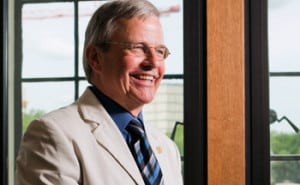ISHMAEL N. DARO
Editor-in-Chief

Peter MacKinnon
At the three public forums scheduled in June, attendees were asked to consider what challenges the next president would face over five or ten years, what qualifications this person should have and whether an academic background was necessary.
The few dozen people who attended a June 9 town hall meeting in Convocation Hall had a seemingly endless list of characteristics they sought in a new University of Saskatchewan president: the president should be from Saskatchewan; he or she should have an international reputation; only someone with a background in academia should be chosen; we need an outsider who can bring fresh ideas; sustainability should be a priority; we need to focus on Aboriginal issues; vision is critical, but so is a sense of humour.
The next president will have to be many things to many people. Or he will have to be Peter MacKinnon, who was universally praised by those in attendance. Indeed, the search committee could well be renamed the Committee to Re-elect the President, given the long shadow he will cast over any successor.
“We want God or a clone of Peter MacKinnon,” joked Nancy Hopkins, the chair of the presidential search committee, near the end of the public meeting.
Hopkins is on the search committee with 11 others, including the presidents of the University of Saskatchewan Students’ Union and Graduate Students Association. The committee will recommend a candidate by early 2012 and the authority to appoint the next president rests with the university’s board of governors.

Members of the presidential search committee hear from students, staff and faculty at a town hall meeting June 12.
“You can get people like Peter MacKinnon who can be inspirational leaders and bring the institution forward and that’s what we are going to find, the next inspirational leader.”
MacKinnon was first appointed president in 1999 and has overseen a massive expansion of campus infrastructure, including the Canadian Light Source synchrotron. He is the second-longest serving president in the university’s history; he will step down in June of next year.
Hopkins said that most of the searches for senior administrative positions at the university end up with the search committee making a unanimous recommendation to the board of governors. Given that Hopkins is also the chair of the board of governors, there is little chance of a recommendation being declined.
The consultation period for the presidential search ends before the school year starts, at which time the committee will already be recruiting candidates for the position. Most students will therefore not have an opportunity to share their ideas with the search committee, and there are no plans for online tools to help do so.
“We are going to rely heavily on the fact that we’ve got presidents of our students’ unions… to bring forward student perspectives on the search,” said Hopkins, referring to Scott Hitchings and Xue Yao.
The next U of S president assumes office July 1, 2012.
—
images: The U of S and
The Sheaf